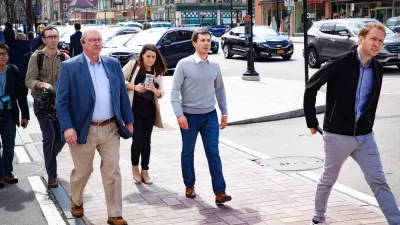Pritzker Prize winner Thom Mayne and leading New Urbanist planner Elizabeth Plater-Zyberk squared off in a debate about the future of Baltimore.

Jared Green reports from a debate that pitted contemporary architect Thom Mayne and New Urbanist planner Elizabeth Plater-Zyberk about the future of Baltimore. According to Green, "[t]heir visions for Baltimore contrast, but the answer to its many economic and social woes may be a little bit of both."
Green summarizes Plater-Zyberk's vision as preserving Baltimore's history at all costs. Plater-Zyberk listed the city's waterfront location, its highly connected street grid, and its historic stock of beautiful buildings as unique assets that could leverage the city revitalization.
Mayne's vision, however, would integrate Baltimore into the global economy. Fans of neighborhoods, new uerbanist or not, might be surprised to hear the crux of Mayne's argument. In his own words: "the precinct, district, township, or neighborhood — the idea of this — is dead. Kids no longer play stick ball in the streets." According to Mayne, there is no on eversion of beauty, as an adherence to the architectural styles of the past might suggest, so Baltimore and other cities like it must pursue a "radical heterogeneity or pluralism."
Green offers his own assessment of the debate, noting a problem "with leading design-thinkers helicoptering in for the day to lay out a city’s future." Green looks around and also sees a lot of efforts already underway to revitalize and redefine Baltimore.
FULL STORY: Which Way to a Better Future for Baltimore?

Alabama: Trump Terminates Settlements for Black Communities Harmed By Raw Sewage
Trump deemed the landmark civil rights agreement “illegal DEI and environmental justice policy.”

Study: Maui’s Plan to Convert Vacation Rentals to Long-Term Housing Could Cause Nearly $1 Billion Economic Loss
The plan would reduce visitor accommodation by 25% resulting in 1,900 jobs lost.

Planetizen Federal Action Tracker
A weekly monitor of how Trump’s orders and actions are impacting planners and planning in America.

Waymo Gets Permission to Map SF’s Market Street
If allowed to operate on the traffic-restricted street, Waymo’s autonomous taxis would have a leg up over ride-hailing competitors — and counter the city’s efforts to grow bike and pedestrian on the thoroughfare.

Parklet Symposium Highlights the Success of Shared Spaces
Parklets got a boost during the Covid-19 pandemic, when the concept was translated to outdoor dining programs that offered restaurants a lifeline during the shutdown.

Federal Homelessness Agency Places Entire Staff on Leave
The U.S. Interagency Council on Homelessness is the only federal agency dedicated to preventing and ending homelessness.
Urban Design for Planners 1: Software Tools
This six-course series explores essential urban design concepts using open source software and equips planners with the tools they need to participate fully in the urban design process.
Planning for Universal Design
Learn the tools for implementing Universal Design in planning regulations.
Caltrans
Smith Gee Studio
Institute for Housing and Urban Development Studies (IHS)
City of Grandview
Harvard GSD Executive Education
Toledo-Lucas County Plan Commissions
Salt Lake City
NYU Wagner Graduate School of Public Service





























